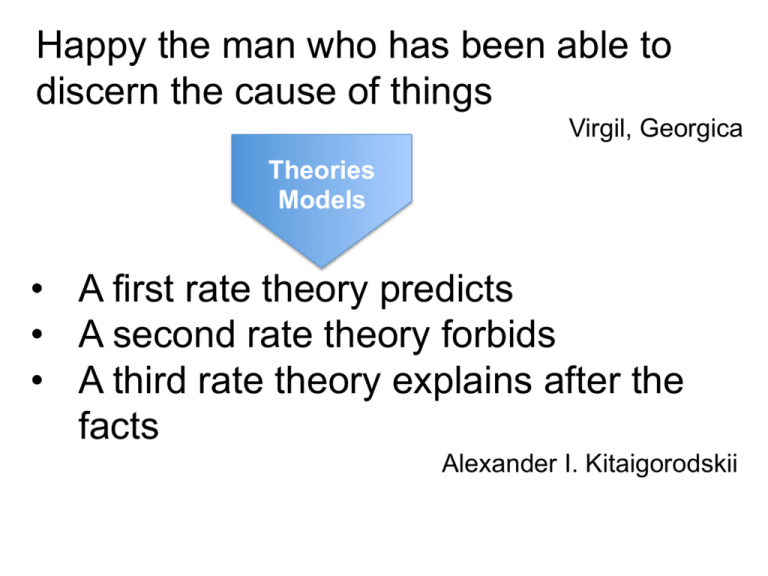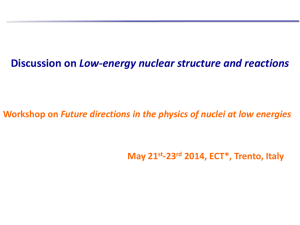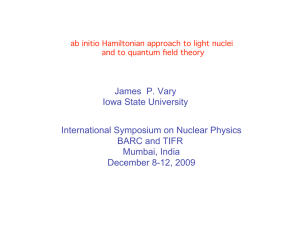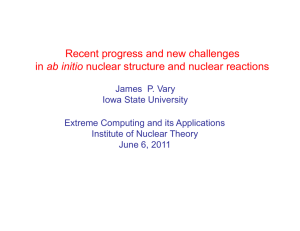• A first rate theory predicts • A second rate theory forbids • A third
advertisement

Happy the man who has been able to
discern the cause of things
Virgil, Georgica
Theories
Models
• A first rate theory predicts
• A second rate theory forbids
• A third rate theory explains after the
facts
Alexander I. Kitaigorodskii
Modeling the Atomic Nucleus
Theoretical bag of tricks…
Nuclear
Many-Body
Problem
The Nuclear
Many-Body
Problem
Hˆ " = E"
Hˆ = Tˆ + Vˆ
A
2
ˆ
p
Tˆ = " i , Vˆ = "Vˆ2b (i, j) + "Vˆ3b (i, j,k)
i=1 2m i
i< i
i< i< k
!
!
two-body
one-body
three-body
Potential energy
Kinetic energy
r r
r
" = "( r1, r2 ,K, rA ;s1,s2 ,K,sA ;t1,t 2 ,K,t A )
3A nucleon
coordinates
in r-space
nucleon
spins: ±1/2
Bottom line:
!
nucleon
isospins
(p or n):
±1/2
A!
# A&
coupled
integro-differential
2 ⇥ 2 " %$ Z (' coupled
second-order
differential
equations
in dimensions!
3A dimensions
in 3A
N !Z! equations
A
A
Eigenstate of angular
momentum, parity, and
~isospin
The nuclear many-body problem
Weinberg’s Laws of Progress in Theoretical Physics
From: “Asymptotic Realms of Physics” (ed. by Guth, Huang, Jaffe, MIT Press, 1983)
First Law: “The conservation of Information” (You will get nowhere
by churning equations)
Second Law: “Do not trust arguments based on the lowest order of
perturbation theory”
Third Law: “You may use any degrees of freedom you like to describe
a physical system, but if you use the wrong ones, you’ll be sorry!”
quark
models
How are nuclei made?
scale
separation
Resolution
LQCD
Origin of elements, isotopes
Hot and dense quark-gluon matter
Hadron structure
Hadron-Nuclear interface
CI
DFT
collective
models
Effective Field Theory
ab initio
Nuclear structure
Nuclear reactions
New standard model
Applications of nuclear science
To explain, predict, use…
Interfaces provide
crucial clues
number of nuclei < number of processors!
Theory of nuclei is demanding
•
•
•
•
•
•
rooted in QCD
insights from EFT
many-body interactions
in-medium renormalization
microscopic functionals
low-energy coupling constants
optimized to data
• crucial insights from exotic
nuclei
Input
Forces, operators
100Sn
240Pu
Many-body
dynamics
• many-body techniques
o direct ab initio schemes
o symmetry breaking and
restoration
• high-performance computing
• interdisciplinary connections
11Li
Open
channels
298U
• nuclear structure impacted by couplings
to reaction and decay channels
• clustering, alpha decay, and fission still
remain major challenges for theory
• unified picture of structure and reactions
Ab initio theory for light nuclei and nuclear matter
Ab initio: QMC, NCSM, CCM,…
(nuclei, neutron droplets, nuclear matter)
Ab initio input
NN+NNN interac+ons Many body method Renormaliza+on Observables • Direct comparison
with experiment
• Pseudo-data to
inform theory
Input:
• Excellent forces based on
the phase shift analysis and
few-body data
• EFT based nonlocal chiral
NN and NNN potentials
• SRG-softened potentials
based on bare NN+NNN
interactions
Few-nucleon systems
A=2: many years ago…!
!
3H: 1984 (1% accuracy)!
!
!
3He: 1987!
!
!
4He: 1987!
!
5He: 1994 (n-α resonance)!
!
!
A=6,7,..12: 1995-2011!
Green’s Function Monte Carlo
(imaginary-time method)
−( Hˆ − E 0 )τ
ψ0 = lim e
ψV
τ →∞
(
trial wave function
)
− Hˆ − E 0 τ
ψ(τ ) = e
ψV
ψ(0) = ψV , ψ (∞) = ψ 0
τ = nΔτ ⇒
§
§
§
§
§
§
§
( −( Hˆ − E0 ) Δτ + n
ψ (τ ) = *e
ψV
)
,
Quantum Monte Carlo (GFMC)
No-Core Shell Model
Faddeev-Yakubovsky
Lattice EFT
Coupled-Cluster Techniques
Fermionic Molecular Dynamics
…
12C
14F, 14C
12C
(Hoyle)
17F, 56Ni
Nucleon-Nucleon Interaction
NN, NNN, NNNN,…, forces
GFMC calculations tell us that:
Vπ / V ~ 70 − 80%
Vπ ~ −15MeV/pair
V R ~ −5MeV/pair short-range
V 3 ~ −1MeV/three
three-body
T ~ 15MeV/nucleon
VC ~ 0.66MeV/pair of protons
GFMC: S. Pieper, ANL
1-2% calculations of A = 6 – 12 nuclear energies are possible
excited states with the same quantum numbers computed
12C:
ground state and Hoyle state
12
C( G . S .) ! 12 C(0+
2 ) ftr F ORM FACTOR
state-of-the-art computing
udinal
form
factor
Wiringa
et al.
Phys. Rev. C 89,
12C
024305 (2014); A. Lovato et al.,
Phys. Rev. Lett. 112, 182502 (2014)
0
10
10-2
0.04
fpt(k)
0
2
r (fm)
4
-2
10-3
10
-3
exp
ρ1b
ρ1b+2b
10-4
0
1
-4
10 0
1
2
3
4
2
k (fm-1)
3
4
0
0
0.5
-1
q (fm )
E [MeV]
|F(q)|
0.00
− M(E0) − AV18+IL7 − one-wa
6 Z ftr(k) / k2 (fm2)
ρch (r)
-1
12C
− M(E0) − AV18+IL7 − one-way orthog. - fpt(k) - 9 May 2013
ΨT O + P2
The ADLB (Asynchronous
6 Dynamic LoadGFMC O + G2
Balancing) version
of GFMC was used to
GFMC 18 + P2
12C5 with a complete
make calculations
GFMC O + P2of
Experiment
Hamiltonian
(two- and
three-nucleon
4
potential AV18+IL7) on 32,000 processors
of the Argonne BGP.3 The computed
binding energy is 93.5(6) MeV compared
2
to the experimental value of 92.16 MeV
and the point rms radius
is 2.35 fm vs
1
Pieper et al., 2.33
QMCfrom experiment.
0.08
10
10
10-1
−82
2+
−84
0+
−86
84.51
−88
−90
−92
82.6(1)
2+
87.72
0+
92.16
Exp
• Data from M. Chernykh et al., Phys. Rev. Lett. 105, 022501 (2010)
2+
• 83(3)
Right panel [ftr (k)/k2 ] proportional to M (E0) at k = 0
+
0
• 85(3)
Large errors at small k due to large Monte Carlo errors
R
+
•288(2)
Can get better value at k = 0 by computing drr2 r2 ⇢tr (r)
• Results with best 0+
2 wave function in good agreement with data
+
0
Epelbaum et al., Phys. Rev. Lett. 109,
92(3)
Th
-91.7(2)
252501 (2012). Lattice EFT
Lahde et al., Phys. Lett. B 732, 110 (2014).
k2 (fm
Ca Average:
51
K
34244.6(61.0)
22516.3(13.1)
same
22002.0(503.0)⇤
V
1.00062561(28)
The frontier:
neutron-rich calcium isotopes
51
1735.5(701.3)
514.3(503.2)
probing nuclear forces and shell structure in a neutron-rich medium
AME2003
TITAN
K
Ca
Sc
18
S2n (MeV)
16
14
12
10
8
6
4
27
52Ca
mass
TITAN@TRIUMF
Gallant et al, PRL 109, 032506 (2012)
28
29
30
31
32
33
34
35
Neutron Number N
FIG. 2. (Color online) Two-neutron separation energy S2n as
a function of neutron number N for the potassium (circles),
calcium (square), and scandium (triangles) isotopic chains.
Points enclosed by a circle are not based completely on experimental values in AME2003. The symbols54
connected
+ by a
Ca
2
dotted line are based on the TITAN mass values (mass values for 49,50 Ca and 47 50 K are taken from Ref. [16]), while the
symbols connected by solid lines are those from the AME2003.
CC theory
transfer reactions.
However, the uncertainties reported
Hagen
al., PRL109,
(2012)
are 2–10 times largeretthan
those 032502
obtained
from the reactions. All masses tabulated in the AME2003 disagree
with the presented measurement by more than 1 . More
sulting behavior of S2n in the potassium and calc
isotopic chains with increasing neutron number is sig
icantly flatter from N = 30 to N = 32. This also
fers from the scandium isotopes, derived from previo
measured mass excess with large uncertainties or f
54Ca: extrapolation.
the AME2003
binding
20 protons,The
34increased
neutrons
the potassium and calcium isotopes may indicate the
18
velopment of a significant subshell gap at N = 32, in
ISOLTRAP@CERN
16 the observed high
with
2+ excitation energy in 52 Ca[
Wienholtz et al, Nature (2013)
14Three-nucleon forces have been unambiguously est
lished
in light nuclei, but 54
only
12
Carecently
mass explored
medium-mass nuclei [2, 6, 7, 37, 38]. These advan
10
have
been driven by chiral e↵ective field theory, wh
8
provides
a Experiment
systematic expansion for NN, 3N and hig
body
[39], combined with renormalization gr
6 forcesISOLTRAP
NN+3N (MBPT)
methods toCCevolve
nuclear forces to lower resolution [
(Hagen et al.)
4
KB3GRef. [6] and calculate the two-body in
We follow
GXPF1A
2
actions
among valence neutrons in the extended pf
40 32 33 34 35 36 37 38
28 top
29 of
30 a 31
shell on
Ca core, taking into account vale
number shells
N
core interactions Neutron
in 13 major
based on a ch
3
N LO NN potential evolved to low-momentum. Ch
3N forces are included at N2 LO, where the two shor
range 3N couplings have been fit to the 3 H binding
RIBF@RIKEN
4
ergy and et
the
Steppenbeck
al He charge radius. For valence neutr
the dominant
contribution is due to the long-range t
Nature
(2013)
pion-exchange part of 3N forces [2, 6]. In Ref. [6],
normal-ordered one- and two-body parts of 3N fo
S 2n (MeV)
20
Anomalous Long Lifetime of 14C
Determine the microscopic origin of the
suppressed β-decay rate: 3N force
0.29
0.03
N3LO NN only
N3LO + 3NF (cD= -0.2)
N3LO + 3NF (cD= -2.0)
GT matrix element
0.02
0.01
0
-0.01
-0.02
-0.03
Maris et al., PRL 106, 202502 (2011)
0.3
0.2
0.1
0
-0.1
s
p
sd
pf sdg pfh sdgi pfhj sdgik pfhjl
configuration space
Dimension of matrix solved for 8 lowest states ~ 109
Solution took ~ 6 hours on 215,000 cores on Cray XT5
Jaguar at ORNL







